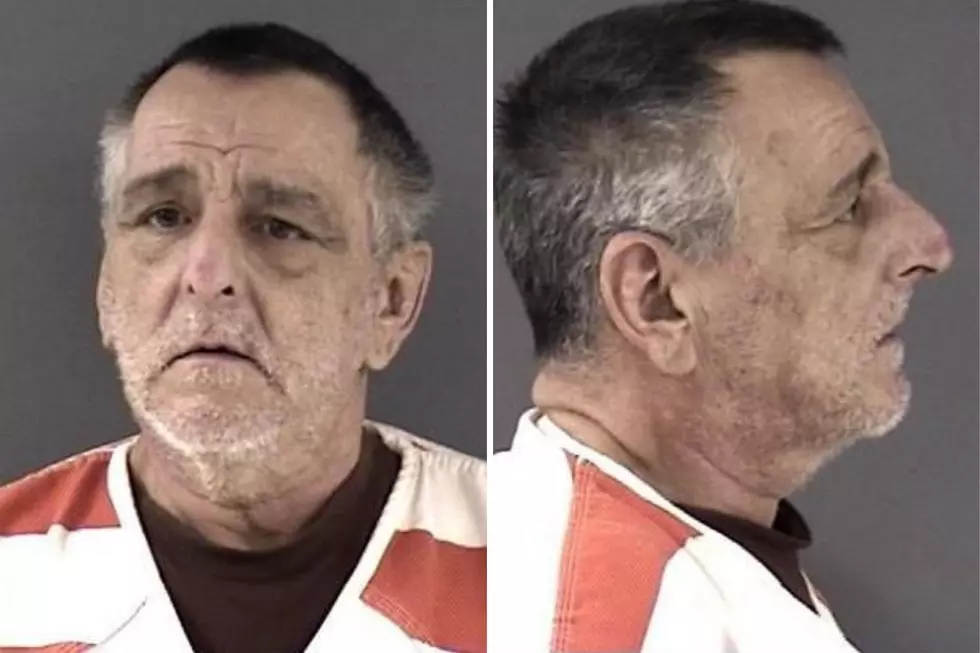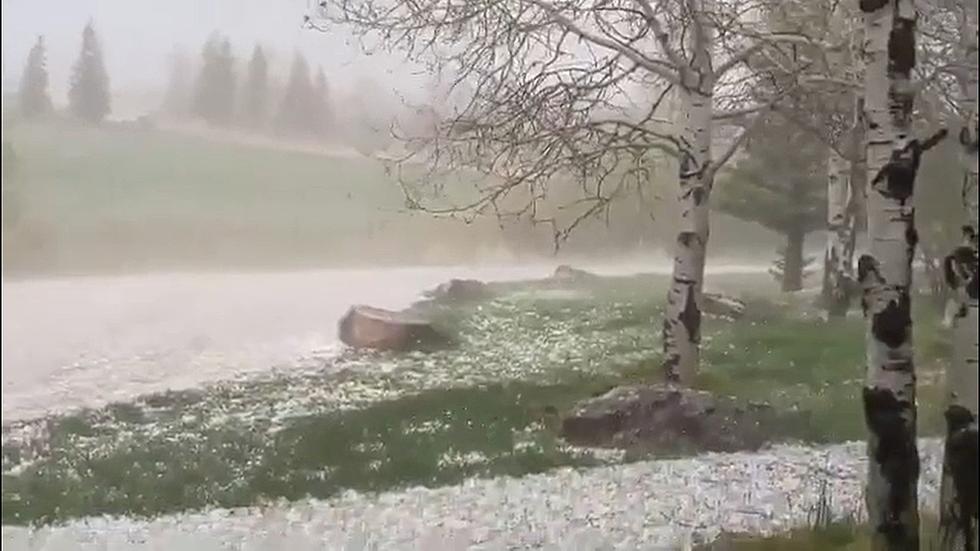
Oil Development Taxes County Roads
With continued talk of a possible oil play in Laramie County, residents in some other parts of the state are concerned about the effects of heavy energy production equipment on county roads. Gregory Nickerson examines the issue in WyoFile.
Shawn Hall runs a farm and feedlot just outside of Veteran, in the agricultural valley of Goshen Hole. It’s a rural area that produces hay, corn, cattle and dryland wheat. Even by Wyoming standards, this is a quiet place. The county road that passes by Hall’s place might see three to four cars a day.
“Some days, it’s no cars,” said Hall.
But recently, that slow pace of life has vanished as his ranch has become an epicenter in the Niobrara oil play.
In 2010, Hall granted a lease to Chesapeake Energy to drill two exploratory wells into the oil-bearing Niobrara shale. The formation is located 6,000-8,000 feet beneath the cows that graze on the surface of his property. Over the last few months, Hall has seen hundreds of semi-truckloads of drilling materials, water and rig equipment roll down the county road to the well pads.
He and his neighbors have high hopes that exploration in the Niobrara formation will lead to an oil boom in southeast Wyoming. If companies find oil, they could bring new prosperity to this historically tax-poor and oil-dry region of the state. Neither Goshen County, where Hall lives, nor nearby Platte County have ever had significant oil production.
“The positives outweigh the negatives 10 to one. There’s going to be a tremendous opportunity here,” said Hall. “We could go from being the poorest county to dramatically changing our position. Platte County, too.”
But while he is happy to see the rigs at work on his land, Hall is also worried about the effects all the traffic could have on the county’s roads.
“Let’s say spring comes along and we’re blessed with a lot of precipitation, like we have been the last few years. You get a lot of (semi) truck traffic on these roads and they get to where they are impassable. That’s a very real possibility,” said Hall.
A destroyed road could be a major inconvenience for Hall and Chesapeake Energy. But it would also be a safety hazard for local residents, and a barrier for emergency vehicles that might need to respond to accidents at the oil wells.
Even worse, a ruined road is a problem that cash-strapped Goshen County cannot afford to fix with its current tax revenues. In an era when rebuilding a paved road can cost more than $1 million a mile, the annual maintenance and construction budget for the Goshen County Road and Bridge Department is a meager $1.6 million.
That’s enough money to build about a mile and a half of road, but only if the county stopped all spending for necessities like snowplowing and grading.
State Rep. Matt Teeters, R-Veteran, has seen the impacts firsthand. He said if Goshen County has 15 to 20 oil rigs working by next summer, the roads will see a lot more damage. That prospect has him worried.
“From the point we start producing oil, it will be 18 months to two years before we receive any tax dollars. How will the county deal with impacts between now and the time we start collecting taxes?” said Teeters.
In neighboring Platte County, Road and Bridge superintendent Jim Lockman sees a similarly urgent situation unfolding.
“The impact might be over by the time they start paying (severance) taxes. The problem right now is the roads can’t carry the traffic they are facing for the next few months,” said Lockman.
All the oilfield impact Lockman is seeing came from six wells drilled in Platte County during 2010, none of which have been completed. It’s probable most of the drilling is still ahead. Tom Doll, Wyoming Oil and Gas Conservation Commission supervisor, said he issued 61 drilling permits for Platte County in 2010.
By comparison, Goshen County had 13 wells drilled and 17 permits issued, with only one well completed last year. Laramie County has seen most of the region’s activity with 38 wells drilled, 115 permits issued and 10 wells completed in 2010.
Doll counted four rigs at work across the three counties earlier this month. With only 11 wells completed, he said it’s too early to tell whether southeast Wyoming will see an oil boom in the region.
Some in the industry say that recent production data indicates that the hype over the Niobrara oil resource — and the likelihood of a high-impact boom — has been overblown. Bruce Hinchey, president of the Petroleum Association of Wyoming, said that based on production reports he’s heard from geologists, he expects a smaller development than others might anticipate.
“I’d be glad if it’s half as big as they hoped for,” said Hinchey.
“You had a lot of scare tactics come in from folks that this is going to be the next Jonah Field,” Hinchey continued. “It’s not going to be anywhere close to that. This is not a situation where everywhere you drill is going to be a barnburner. There are going to be sweet spots and sour spots.”
Even so, the current exploration in Platte, Goshen and Laramie counties is already putting significant stress on county roads. Local officials are facing budget shortfalls and hearing from concerned residents like Hall, and they are calling on the Legislature to help cover the costly impacts of present and future oil development.
NEW TECHNOLOGY, NEW IMPACTS
The companies working in the Niobrara oil play use deep multi-directional drilling and hydraulic fracturing techniques developed over the last decade, most recently in the oil-rich Bakken formation in North Dakota and Montana.
The entire drilling and fracturing — or fracking — process costs about $5 million per well and employs between 50 and 100 people, including rig hands, truck drivers, geologists and engineers, according to industry officials.
A typical Niobrara formation well is 6,000 to 8,000 feet deep, with horizontal leads that can stretch nearly a mile from the vertical bore. Multi-directional wells make for less surface disturbance compared to vertical wells, with one well per 640 acres. By comparison, some natural gas fields in Wyoming are drilled on 160-acre spacing, while others are spaced only 20 acres apart, or even less.
The heavy impact in the Niobrara instead comes from the thousands of truck trips needed to haul in the materials to drill and frack a well.
“It takes about 30 or 40 days to bring in all the materials to start the (fracking) process,” said Goshen County Road and Bridge Department superintendent Gary Korrel.
During that time trucks are constantly delivering material to the site.
“Once they have all the materials there it only takes three or four days to frack,” Korrel said.
Korrel estimates a well requires 6,600 tons of gravel for the well pad, plus 4 million pounds (2,000 tons) of frack sand and chemicals, which are injected into the production zone of the well to break apart the rock so oil can flow into the well.
Doll said the Niobrara oil wells completed so far have required an average of 1.2 million gallons of water to frack. If there is no local source of water it must be hauled in by tanker-truck at about 3,750 gallons a load. That makes for an estimated 320 semi-truck trips, and a major impact on county roads.
CALCULATING THE DAMAGE
Local officials know their rural roads were never meant to handle this kind of industrial traffic.
“We’ve seen some of the roads disintegrate. These roads were designed for pickups and horse trailers, not the 100,000-pound loads we’re seeing,” Teeters said.
Laramie County Road and Bridge Supervisor Don Beard said bad weather conditions worsen the damage caused by heavy trucks.
“They don’t care if the road is frozen, if it’s raining, or snowing, too hot, too dry, too windy, or too cold. They’ll operate on those roads and that’s where the damage begins to occur,” Beard said.
The combination of weight and weather is a good recipe for destroying cheaply built dirt and gravel roads. Some of the rural roads in Goshen County are built of dirt with a three-inch gravel surface. While this is sufficient for most current use, according to Korrel, a road that can sustain heavy oilfield traffic should have a thicker gravel base of 6 to 8 inches.
The paved roads of Goshen County are also at risk.
“Our single biggest concern is the oiled roads. Those are 30- 50-year-old paved roads, which are still adequate for current use, but are not going to take a lot of added traffic,” said Goshen County commissioner Ross Newman.
While officials in Platte and Goshen counties do not know whether the Niobrara boom will pan out, they have already started making plans on how they could meet road impacts. Korrel has been in touch with at least one company that volunteered to do light maintenance on a local road. He wants to work with more companies in the future to develop road use agreements and locate routes that could best withstand impacts.
Hinchey said oil companies often make agreements with local governments to help with road maintenance.
“The industry has to get out to the worksite, so they’ll plow the roads, but they have to have an agreement (with the county) to do that,” Hinchey said. “It’s worked well in other areas. It’s just a question of if the counties are willing to do that.”
Teeters said county officials are talking with companies about creating road use agreements. Goshen County is conducting traffic counts and documenting road conditions prior to development so officials there will know if companies leave roads in the same condition they found them.
“We’ve already seen the companies putting water on the roads and repairing damage in the counties. They have a lot of financial resources to do things correctly. We hope they won’t pillage the community,” Teeters said.
While companies are often willing to do the work of road maintenance, Hinchey said the Petroleum Association of Wyoming would be opposed to requiring the industry to pay fees to counties for the use of county roads.
“A fee is just another word for a tax in my opinion. If you look at the oil and gas industry, we pay a tremendous amount of taxes that no one else pays. If they do want to put a tax on, it should be equal and uniform, rather than a tax on one industry,” said Hinchey.
In the hopes of getting road money from the state, Goshen and Platte counties each have prepared estimates of what it would cost to repair current impacts and bring their roads up to a standard that could handle future oil development. Korrel estimates that Goshen County could upgrade its roads, bridges, cattle guards and culverts for $7 million to $8 million.
Lockman estimates that widening and resurfacing affected roads in Platte Count would cost about $16 million, or nearly 20 times the annual county road and bridge budget of $835,000. The picture is more complex in Laramie County, which has seen greater impacts because there are more oil wells in all areas of the county. Beard is in the process of preparing an estimate.
As a preliminary figure, Beard said Laramie County’s current annual road and bridge budget of $6 million, “could build six miles of road.” But that’s only a small fraction of the roads he’s responsible for.
“I have 220 miles of paved road, and approximately 100 miles of that in distress,” Beard said.
His department also maintains another 1,200 miles of gravel roads, with an unknown number of miles in disrepair. Beard said he is faced with a large imbalance between his annual budget and the huge amount of work that needs to be done.
“The positive side is we will get through it. We’ll come up with fixes for it, and we’ll do the best we can with the resources we have,” Beard said.
Road and bridge officials stress that preventative maintenance, though expensive, is actually a bargain.
“It would take a lot more money to come back and rebuild the roads after they fail,” Korrel said.
HASHING OUT A SOLUTION
The situation these counties are facing is nothing new. Wyoming has a long history of industrial development in rural areas, ranging from coal mines to gas pipelines to recent natural gas booms in the Powder River Basin and the Upper Green River.
Coal mines and large gas plants have long been under the jurisdiction of the Wyoming State Industrial Siting Council, which provides a mechanism for local governments to address impacts they incur.
Oil and gas development, however, is rarely subject to such laws, according to Sarah Gorin of the Equality State Policy Center, a government watchdog group whose members include environmental groups and union organizations. The Industrial Siting Council has jurisdiction over projects costing more than about $178 million, according to the latest indexed threshold. But most oil and gas development occurs rapidly and is split up across many well sites and extraction companies, and typically fails to meet that threshold.
Lacking a formal process for estimating impacts or placing impact taxes on oil and gas companies, counties have resorted to asking the state to cover such costs.
In 2004, the legislature helped counties deal with some impacts from coal-bed methane development through a one-time $10 million appropriation.
But officials in the counties affected by the Niobrara oil play are hoping the legislature will develop a new attitude toward covering impacts.
“All we do in the legislature is react. And it would be really nice after all we’ve been through in Wyoming to be a little proactive on this one, because we’ve seen it happen before,” Teeters said.
In Laramie County, Beard is also hoping for new thinking about oil industry impacts.
“Wyoming is a mineral state and one of the things that we seem to never do here is to protect the boom communities – wherever they are at (in the state). They always try to come in after the impact has occurred and repair the damage that’s been done. That way of thinking is a little backwards,” Beard said.
Beard said he thinks that the Industrial Siting Act could provide a good template for managing the development of oil and natural gas.
“With industrial siting you really have the ability to make (development) go right and steer it. We don’t even have a steering wheel with the oil companies. They are going to be everywhere and go where they want, and they have the right to do that on public roads,” Beard said.
Gorin said Wyoming could come up with a process that aggregates the total impacts of oil development across multiple companies to determine whether development is big enough to trigger siting council attention.
For example, various companies working in the Niobrara have spent about $5 million to drill each of the 57 oil wells in southeast Wyoming at a total cost of approximately $285 million. With a number like that, the siting council could use its permitting powers to apportion the costs of impacts among those responsible. Such a process could bring order to the chaotic impacts of oil development.
But Gorin is almost certain that the oil and gas lobby in the state legislature is too strong for such a proposal to become law.
“There is always the fear among legislators that if they try to impose conditions (on oil companies) then the development will go elsewhere. That’s the number one card industry plays: ‘If you aren’t nice to us we’ll go somewhere else,’” Gorin said. “You’ll take our oil and go somewhere else? I don’t think so. But it is very effective (rhetoric).”
Meanwhile, Sen. Curt Meier, R-LaGrange, is drafting a bill that would anticipate future tax revenue from the development and enable impacted counties to borrow money against that future severance tax revenue.
“The energy industry funds the whole state of Wyoming, and we’ve got the money to be able to handle it,” said Meier.
In an early draft of the bill, Meier said the counties would borrow from a pool of money withdrawn from the Permanent Mineral Trust Fund managed by the state treasurer. Counties would agree to pay back the loan plus interest calculated on the typical rate of return earned by the Permanent Mineral Trust Fund.
The bill is designed to adjust for the unpredictability of oil development, according to Meier. If oil production booms, the counties would use money generated from severance taxes to pay back the loan. Should oil production and severance tax revenues fail to materialize, the bill would require the state legislature to cover the county’s debt with an appropriation from the general fund.
Sen. Bruce Burns, R-Sheridan, said the bill reminds him of a proposal he floated to the Sheridan County Board of Commissioners during the coal-bed methane boom in 2004-05, when they were in need of road money. The difference is that the coal-bed methane boom was already a sure thing at the time.
“I generally like the idea,” Burns said. But, “The difference is, what happens if the Niobrara play doesn’t come into effect?”
To add flexibility, Meier said his bill would give the State Loan and Investment Boardthe authority to grant, rather than loan, money to affected counties.
Meier said he expects to introduce his tax-anticipation bill during the current legislative session. He describes it as an attempt to create a long-term solution to pay for impacts. Additionally, he will propose a temporary remedy for the Niobrara oil impacts by requesting a one-time general fund appropriation to cover road repair in southeastern Wyoming.
Senate File 107, “Energy impacted county roads program,” was introduced on Monday and sent to committee.
Not surprisingly, the heads of the road and bridge departments in southeastern Wyoming have strong opinions about how they would like the state to deal with impacts.
“I would really prefer it wasn’t a loan that had to be repaid. If the state has that much money in surplus I’d like (them) to give a big percentage of that to counties with oil play,” said Lockman of Platte County Road and Bridge.
Korrel said he’s been frustrated that Goshen County has to ask for the money in the first place. The state has already seen a large amount of money flow into the school trust fund due to selling leases on state sections for the Niobrara oil play.
While he knows state law requires money from state leases to go to schools, Korrel would like to see the state lease money balanced by an impact appropriation from another fund.
“The county isn’t seeing any of that (state lease) money back, and we’re the ones being impacted. We’d like to see a little money flow back to take care of these roads,” Korrel said.
Beard insists that the state should have a large fund set aside for covering road and bridge impacts, from exploration traffic, whether or not full-scale development actually occurs.
“The counties should be able to come in and say, ‘I have this impacted condition, this is what I need. This is my research, and some documentation, and I need $10 million,’” Beard said. “This fund should not be small. They are putting a lot of money into the mineral trust. They should create something where a county could go in and not worry about taking care of an impacted road.”
But Beard predicts that legislators will say impact assistance isn’t needed because Laramie County will get its severance tax money eventually.
“We need to modernize their thinking. We need to take care of impacts as they occur, not later,” Beard said.
WyoFile is a nonprofit news service focused on Wyoming people, places and policy.
More From KGAB









